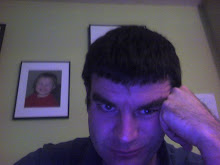Yesterday I took the boat across Lago de Atitlan, planning to stay there that night, but I found a cheap ride to Chichicastenango, and decided to go.
The name Chichicastenango comes from a Mayan word that meant "Nettles Heights." It was a Kaqchiquel city that was conquered by the Quiche king Kiquab in the early 15th century. Most people come here for the enormous market that takes place on Thursday and Sunday, but I was looking for something else. It was here that the Spanish friar Francisco Jimenez found the transcript of the Popul Vuh written by Mayan scribes in the Latin Alphabet version of Quiche.
This is the convent that Ximenez lived in. It is next to the Spanish-built church, which is between 400 and 500 years old. There is a plaque commemorating Ximenez's translation here. Ximenez was a friar devoted to converting the Maya, so he knew both Spanish and Quiche. Yet unlike other Spanish priests he transcribed the Quiche text and his own Spanish translation as best he could, with only a few disapproving notes about the influence of the Devil along the way. Sadly, the manuscript that Ximenez copied from is lost, as is the heiroglyphic scroll that the Quiche scribes copied their Latin text translation from. The loss of both these manuscripts is incalculable, because alphabetic text cannot convey all the graphic elements in the Mayan heiroglyphic language. According to Dennis Tedlock, the authorotative English translator of the Popul Vuh, the original heiroglyphic manuscript would not be written in a the narrative style we have now. It would mostly be notes about the motion of Venus and other planets with images that displayed the important stories. The Quiche scribes would have written the stories that the daykeepers would have told to accompany the text. But the Latin version likely had pictures as well, since many of sections open with text that is clearly meant to describe accompanying images.
This is the Spanish church, built in the 16th century. It's hard to get a good picture of it, since the stalls for the market go right up to the steps. The steps are steep and high, similar to the steps in front of the Metropolitan Museum in New York. It seems clear that the Spanish copied the style of the steps leading up to the Mayan temples. People kneel on the steps now and burn incense in swinging coffee can containers. They burn flower petals and candles and copal on the steps as well. There is a shrine in the middle where pieces of copal are always burning. There are no pictures allowed inside the church, for obvious reasons. It's a very active church, and there are people in there all the time worshipping. The ceiling is a high wooden corbeled arch, maybe 50-60 feet off the ground. The walls are white-stuccoed adobe, gray from the incense smoke that's always filled the church. It's maybe 50 feet wide, and 200 feet long, and along the sides of the walls are tall carved wooden shrines reaching most of the way to the cieling with recessions containing carved wooden milagros of various saints. The altars have rectangular faces that at first appear to be plain wood, but if you look closely you can see that they are old paintings of biblical scenes that have been obscured through centuries of incense smoke. An art restorer who got in there could probably uncover some amazing old paintings there.
There are also glass cabinets near the front door that contain larger figures of various saints. For each saint there is a cofradia, a religious society of men who come in the church and burn incense and candles for the saint. Right now, probably because Semana Santa is approaching, the church is hung with bright purple fabric and has several floats of saints that belong to the cofradias. Unlike the stern old milagros in the cabinets, these milagro floats are decorated with flowers, bright parrot feathers and mirrors encased in bright fabric. They are brightly dressed in clothes that have quetzal notes hanging off them. I sat through a service in the church yesterday, but during the whole service men from the cofradias were walking back and forth in front of their milagro floats on their knees burning incense.
There is also a much larger float, perhaps 30 feet long and 10 feet high and made of dark, carved wood. It has figures of angels in Semana Santa purple on it. I know from the ceremony I saw last year in Antigua that the cofradias carry this enormous float on their shoulders, probably mounted with the large figure of Jesus carrying the cross in the middle of the church.
There is a smaller church across the plaza, and I was able to get a better picture of it. The cofradias were also active in front of this church.
I have so much more to write, but no time now. When I get back online I will talk about the shrine of Pascual Abaj and the Museum of Masks.










No comments:
Post a Comment